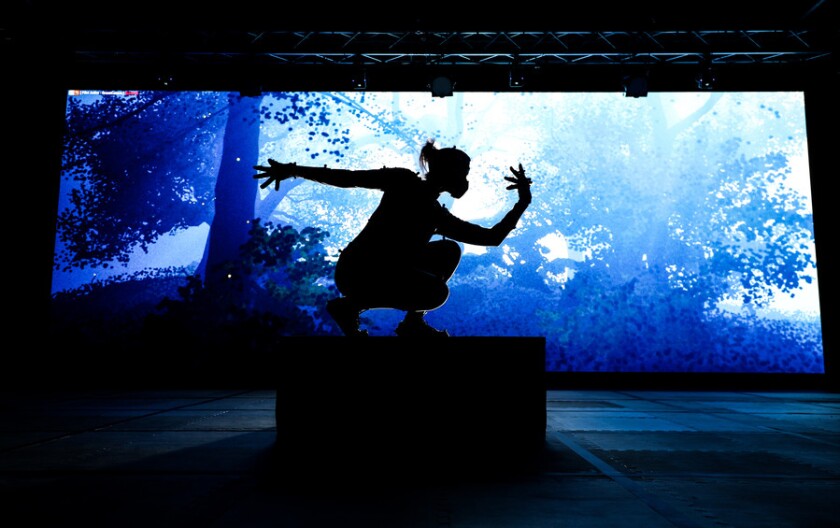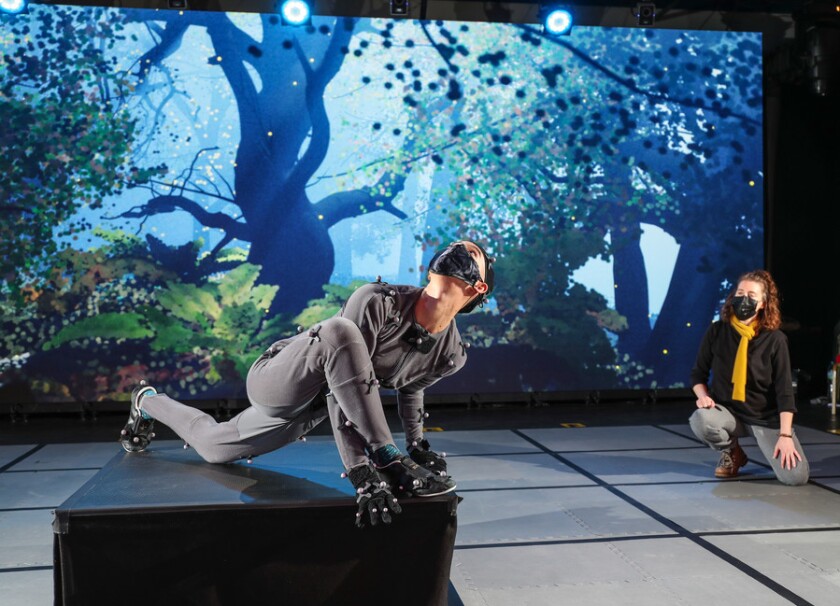
Eight actors are deep into rehearsal in a studio in Portsmouth, England, a little more than a week before the first public performance of “Dream,” the Royal Shakespeare Company’s online work inspired by “A Midsummer Night’s Dream.” As the actors work, director Robin McNicholas rattles off some of the cultural touchstones that inspired the production. Among them: popular video game “Fortnite” and “Bandersnatch,”the choice-driven episode of Netflix’s “Black Mirror.”
“The games industry releases a work and iterates,” says McNicholas. “As users interact, living story worlds evolve. We see that in mass-audience examples such as ‘Fortnite.’ The dynamic that causes that is somehow so much more compelling than, say, a traditional model of beginning, middle and end. In this show, we’ve made sure each production is going to be very different.”
Each show, in fact, will be interactive. Audience members will play the role of fireflies, performing, if they choose, as luminous digital characters who bring a magical forest to light. Although the 50-minute story will follow the play’s mischievous character of Puck and forest fairies Cobweb, Mustardseed, Peaseblossom and Moth, it will deviate mightily from the William Shakespeare text. Here, the Royal Shakespeare Company is using a setting and inviting the audience to play.
Indeed, “Dream” will likely feel a bit like a game.
Actors in “Dream” will perform using motion-capture technology in a world created by Epic’s Unreal Engine.
(Stuart Martin / Royal Shakespeare Company)
That’s by design. “Dream” even uses game technology. Epic Games’ Unreal Engine — the creative tool that powers a range of entertainment including Epic’s own “Fortnite” and Hollywood productions such as “The Mandalorian” — will not only create the evolving forest of “Dream” but also will use motion-capture technology to transform actors in real time. “Dream” was concocted during the pandemic, but expect the lessons from its merging of immersive theater, video game tech and user interactivity to long outlive the COVID-19 era.
That’s because “Dream” speaks to a larger and broader cultural understanding of the narrative power of play, and how we connect through games via screens and beyond. Ask McNicholas, for instance, about the Shakespeare work, and he’ll trail off to instead discuss Meow Wolf, the Santa Fe, N.M.-based art collective that built a suburban home and a black-lighted wonderland inside an empty bowling alley and just opened a second space in Las Vegas, where a not-quite-as-it-seems supermarket is a jumping-off point to psychedelic landscapes.
“To have an open world and that non-linearity is a beautiful thing,” says McNicholas, citing his appreciation for the way Meow Wolf’s experiential setting creates a tale without end, a place that becomes home to ritual rather than a story. “In that kind of meta-modernist setting, story and nonlinear narrative can coexist. That’s crazy, but it’s majestic. It’s the same way that humor and seriousness occupy our daily life.”
Theater traditionalists shouldn’t worry.
There will, in fact, be no shortage of typically refined productions of Shakespeare’s works when the pandemic ends. But gradually garnering a stronger cultural foothold is a form of entertainment in which creators use game techniques to build worlds rather than plots. This can be done on a grand scale, such as Disneyland’s Star Wars: Galaxy’s Edge, where guests enter a lightly ongoing story to reenact one of America’s most popular modern myths.
“Dream” will use video game tech to bring the audience into a magical forest.
(Stuart Martin / Royal Shakespeare Company)
Or one can take a smaller but no less ambitious approach, such as the experimental route the Royal Shakespeare Company is undertaking for the nine-day run of “Dream,” beginning March 12. “I think, at the core of this, it’s just really cool what they’re trying to achieve,” says Epic Games’ Ben Lumsden, who focuses on real-time production and has been working closely with the Royal Shakespeare Company.
“They’re imagining what the future of storytelling looks like,” says Lumsden, “and understanding the difference between linear storytelling and what can be interactive.”
That being said, the Royal Shakespeare Company knows its audience may include more-traditional theater fans; they all might not be familiar, say, with the viral user-generated production that meshes “Hamilton” with “Animal Crossing: New Horizons.” So, there is a relatively linear narrative to “Dream,” meaning there is a path for our fireflies to follow and not something akin to a go-anywhere, open-world video game. And yet the show, a collaboration among numerous entities, including the Esa-Pekka Salonen-conducted Philharmonia Orchestra, is designed to speak to current concerns such as the pandemic and climate change.
Audience participants, of which there can be up to 2,000, will gently guide Puck’s journey through the forest by clicking or tapping their screens, depending on the device (a tech check is run prior to the purchase of a 10-pound, or $13.96, ticket for those who opt to interact with the show). The audience will then light the way to inspire improvisation, shifts in actor choreography and small environmental interactions.

The forest in “Dream,” as rendered in Epic’s Unreal Engine. Audience members will explore this world as fireflies.
(Royal Shakespeare Company)
The audience will in a way be lighting directors, and there will be a point at which collaboration is essential to the performance. The belief and hope are that various audiences will behave differently, resulting in uniquely individual shows. Those who don’t want to play can register for a free view-only stream.
“The reason we find this is interesting is because if you look at ‘Minecraft,’ if you look at those gaming worlds, there is a social-ness and a convening there amongst people enjoying an experience,” says Sarah Ellis, director of digital development at Royal Shakespeare Company. “I think that relates to theater. We are using the technology of gaming, and we are in the spirit of live performance, and we are trying to establish a connection point.”
Epic’s Lumsden says we’re not too far from a post-pandemic future where live audience members are given augmented reality glasses. Imagine, say, the spirit of Ariel in a work such as “The Tempest,” which can be rendered in real time with game tech — as the Royal Shakespeare Company has done in the past — but could with AR soar among the seats and throughout the auditorium rather than on an LED screen. There’s evidence that we’re heading toward such a reality. Universal Studios Japan, for instance, just opened the first major theme park attraction to utilize AR technology with a “Mario Kart”-themed ride.
“There’s a lot of fun to be had when you’re doing improvisational things,” says Lumsden, noting that Epic has been making grander overtures to the live entertainment space. One can imagine, perhaps, a version of “Dream” that is performed in front of a live audience, with those seated interacting with the environments via their smartphones, along with a remote audience playing along at home. Ellis dismisses the idea that more conventional theater-goers aren’t ready or willing to lean in and participate.
“All of theater is interactive,” says Ellis. “If you sit there and passively experience, you’re interacting. We get show reports, and it tells us how the audience is feeling. You interact.
“But I think the partnerships we brought in, and how to build a world in a digital environment, were very interesting to us,” Ellis continues. “How do you converge the stage and world-building? We’ve been implicitly looking at this and haven’t had the opportunity. So when we move forward, we have this in our toolkit.”
McNicholas, who comes to “Dream” from London art collective Marshmallow Laser Feast, which took the lead on the digital-world creation, says another goal is to show that the so-called highbrow world of theater isn’t all that disconnected from video games, still often stereotyped as more of a lowbrow medium. Games themselves are an act of performance, a dialogue between a player and the character or universe on the screen.
“I just think down the line the experiential sector is going to benefit from the act of play,” he says. “Play is such a human thing.”
One, perchance, may even say that play’s the thing.


